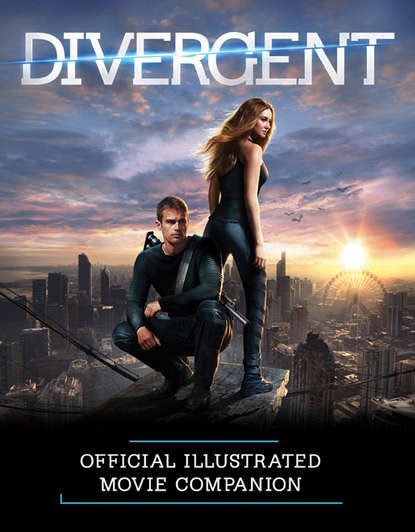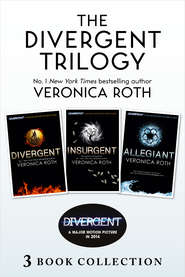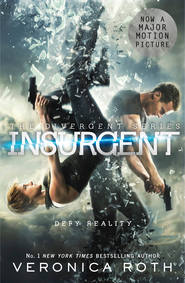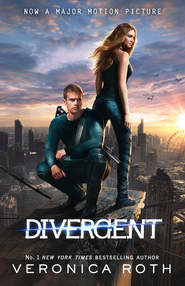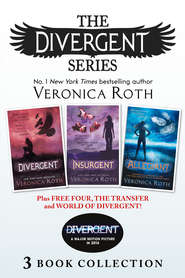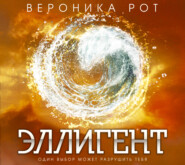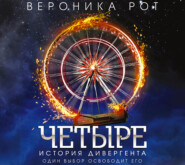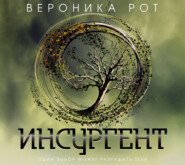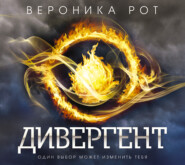По всем вопросам обращайтесь на: info@litportal.ru
(©) 2003-2025.
✖
The Divergent Official Illustrated Movie Companion
Настройки чтения
Размер шрифта
Высота строк
Поля
Sixteen-year-old Beatrice Prior, born into Abnegation, knows she doesn’t belong fully in any of these groups. Her aptitude test has revealed something terrible: She’s suited for more than one faction.
Divergent, it’s called. In this world, that’s a dangerous thing to be. Peace and stability depend on people pledging loyalty to one faction above all else—even family. But a person who doesn’t fit into any category could have divided loyalties. And a person with divided loyalties might not be easily controlled.
Beatrice can’t share this secret with anyone, not even her parents. But now she knows there’s a reason she’s never felt quite like the rest of her quiet, self-sacrificing family. Now she knows why she’s always been drawn to the daring Dauntless kids at school. She could be one of them, too, if she wanted.
Tomorrow, she will have to choose.
The faction system allows Beatrice to leave Abnegation for another faction at the Choosing Ceremony. There’s only one catch: It will mean cutting ties with her family forever.
Poised at the edge of adulthood, this girl must make a permanent and life-altering decision, with consequences she can’t foresee. Should she stay safe inside the limits she has always known, together with her family? Or should she take a chance on what’s in her heart and leave everything else behind?
Veronica Roth sets up this conflict in the opening chapters of her stunning 2011 debut novel, Divergent. It’s as if she has distilled the entire teen experience into these few pages, recognizing that moving into adulthood can also mean leaving beloved people and places behind.
Shailene Woodley as Beatrice “Tris” Prior.
As Roth explains it, “I think it’s the classic coming-of-age moment, but exaggerated. At some point in your life you have to decide if you’re going to stick with the way you were raised and fully commit to what your parents have taught you to do, or to listen to your own internal compass. And sometimes your internal compass leads you to where your parents actually wanted you to go. I don’t think any teenager’s really experiencing this on quite so intense a level, but I think it’s the reason so many people have connected to the story.”
What will Beatrice choose? The rest of Roth’s ambitious tale unfolds from this question.
When Beatrice chooses to go—and to grow—she leaps into Dauntless, a faction that’s the opposite of everything she’s known before. In Dauntless, she accepts challenges and embraces dangers that leave her both terrified and exhilarated. She grows close to other people for the first time—including Four, the mysterious instructor with whom she has an electric connection. She becomes, in some ways, the person she’s always wanted to be. She even gives herself a new name: short, sharp Tris.
The Prior family hugs before the Choosing Ceremony (L to R: Ansel Elgort, Tony Goldwyn, Ashley Judd, Shailene Woodley).
Still called Beatrice (Shailene Woodley), she makes her decision at the Choosing Ceremony.
Tris is uniquely unqualified for the rigors of the Dauntless initiation, which require her to be aggressive in a way that would never be allowed in Abnegation. If she fails, though, Tris will be factionless. Homeless, abandoned, and alone. Somehow, she finds the strength to push through.
But Divergent is much more than the story of a girl beginning to shape her own destiny. Roth also uses her novel to explore the limits of a rigid utopian society. The aptitude test and the Choosing Ceremony exclude and deny Divergents. But it’s in her Divergence, finally, that Tris finds her greatest strength. When she embraces the full range of her qualities as a human being, she can play an active role in her world. Even as it is falling apart.
While once Tris believed that the factions lived side by side in peace, she understands her world differently now that she’s inside Dauntless. There’s tension among the initiates from different factions, and that tension reflects what is happening beyond the Dauntless pit. Erudite is moving against Abnegation to seize control of the government. Then the Erudite will use the Dauntless—the society’s soldiers—to do their will.
Tris (Shailene Woodley) and Four (Theo James) on the Ferris wheel during Capture the Flag.
But there are some Dauntless who can’t be controlled. The ones who are Divergent . . . like Tris.
Against the twin backdrops of a crumbling utopia and a powerful first love, Tris must forge her new identity, accept what it means to be Divergent, and find a way to protect the family she’s left behind.
Author Veronica Roth did not set out, at first, to write a dystopian novel at all. When she was in her first year of college, she began with a single image of a person jumping off a building, as a test of bravery, and started to ask herself some questions. Who would do that? she wondered. And why?
In the psychology class she was taking at the time, Roth remembers, she was studying exposure therapy. “It’s a way of treating people with anxiety and phobias in which they are repeatedly exposed to the stimulus that frightens them,” she says. “So someone who is afraid of heights will go into an elevator for longer and longer periods, say, until their brain rewires and they’re not as afraid of that thing anymore.” When she thought of the person jumping off the building, she saw someone trying to face their darkest fears.
Soon she invented the idea that this person—a boy she was calling Tobias—would confront his fears in an artificial environment, sometime in the future. “So the idea for Dauntless came from these simulated environments in which a person can encounter their fears safely,” Roth recalls. “And the theory of the Dauntless is that over time the fear will be gone and you’ll create fearless people.”
If there was a group where people tried to conquer fear, Roth decided, there could also be other groups in her futuristic setting, each dedicated to conquering other flaws in the human character. If all the groups succeeded, they’d have a society that lived together in harmony and peace.
Tris (Shailene Woodley) prepares to jump into the Dauntless compound.
Roth says, “The other factions evolved when I thought, ‘If I were creating a utopia based on eradicating personality flaws, or fostering virtues, which ones would I choose? Which ones would be most important?’ So after Dauntless came Abnegation, because I think that selfishness is a pretty easy explanation for world problems. And Erudite, or intelligence, came after that. Then Amity—peaceful friendship—and Candor, because it occurred to me that honesty would also be important.
“But the trick with this,” she continues, “was finding out that, even though this is my utopian vision, something about it is flawed. This is all supposed to be good for society, right? But really, it’s not. I had to figure out how the virtues would go wrong.” Taken to extremes, she knew, even the best human qualities would go sour. Roth explains, “It’s a hallmark of dystopian fiction that it comes from someone’s vision of perfection.” While the factions start with a commitment to certain ideals, the ideals erode as they meet the realities of daily life.
With her ideas for the Dauntless and the other factions, Roth began to write Tobias’s story, but she got only about thirty pages in before she realized it wasn’t working. For several years, then, she put the story aside.
Cast members from all of the factions mill about in an opening scene of Divergent.
A young Veronica Roth was destined to be a writer.
Fast-forward to Roth’s senior year at Northwestern University, where she was studying creative writing. She had always loved science fiction and fantasy, as well as young adult novels, including The Giver and Ender’s Game. For her coursework, though, she was writing nothing of the sort. Few of the other students shared her interest in these genres, and her assignments required a different kind of voice. Roth still worked on her pet projects, during late nights or over vacations, but she didn’t share them with her classmates.
That year, Roth decided the story about Tobias needed an overhaul. Tobias would remain a character, but the story would be told from a different point of view, that of a strong and unyielding Abnegation girl named Tris.
“I’m not really sure why it didn’t work with Four as the protagonist,” says Roth. “I think part of it is that it’s a little more interesting to tell the story of a young woman leaving a perfectly safe, very controlled environment, and going into an incredibly dangerous and risky one. There is something, given our cultural climate, that makes that a more interesting story. We might expect an impetuous young man to join Dauntless, so that wouldn’t be surprising to us. But a young woman choosing Dauntless—especially a very small young woman—this is crazy! So maybe that’s why the story ultimately worked when I chose Tris as the narrator.”
After she imagined Tris, Roth’s disparate ideas suddenly came together into a compelling whole. Roth remembers, “I was pulled in by Tris. I was fascinated by her voice, and I first wanted to create the circumstances in which that voice emerged, and then see what she could tell me about what was happening in her world.” Undistracted by schoolwork, Roth focused on this project over winter break, and it rapidly grew to the length of a novel.
Then, in storybook fashion, things changed very dramatically for Veronica Roth. Some months before this, she had attended a writers’ conference, connected with a literary agent—Joanna Volpe—and submitted a manuscript to her, which Volpe ultimately rejected. When the story of Tris and Four was finished, though, Roth sent it to Volpe first. Within one month, Volpe agreed to represent Roth and also sold the rights for the entire Divergent trilogy (which was not written yet) to Katherine Tegen Books, an imprint of HarperCollins Publishers.
Not bad for an author who was about to graduate from college.
Arriving at the height of a red-hot moment for dystopian young adult fiction, and offering just the right balance of full-throttle action and powerful romance, the book was a sensation before it was even published. Buzz built within the publishing company as editors Molly O’Neill and Katherine Tegen shared the manuscript with their marketing and sales teams. Booksellers and librarians devoured the advance copies, certain they were reading the next big thing. Roth stoked the excitement as well, with her candid and approachable blog. When the book was finally published in May 2011, it debuted at number six on the New York Times Best Sellers list and kept climbing steadily to the top spot.
By then, a film was already in the works.
Author Veronica Roth’s first visit to her publisher’s headquarters in New York City.
Divergent’s debut on the New York Times Best Sellers list.
(#ulink_442c0234-713d-5bce-b2b6-dede3761e798)
Author Veronica Roth with producers Doug Wick and Lucy Fisher.
ENTER HOLLYWOOD
Red Wagon Entertainment producers Doug Wick and Lucy Fisher came upon the manuscript before it was published and were smitten with what they read. They immediately brought the book to Gillian Bohrer, Executive Vice President of Production and Development at Lionsgate. Gillian remembers reading Divergent for the first time one weekend in January 2011. As the book wasn’t published yet, she was reading photocopied pages in a coffee shop, and the page that described Tris’s decision at the Choosing Ceremony was . . . missing. “I had to know what happened!” says Bohrer. “I read ahead and figured it out. And then I couldn’t stop reading. I just couldn’t put it down.”
That Monday morning, she started spreading the word at Summit. “I knew the story would break through to a movie audience,” Bohrer remembers. “It had so many themes that would resonate with teens, from challenging your limits to finding your own family. Plus it had these amazing set pieces, from the Choosing Ceremony to the Ferris wheel and the zip lining. . . . I could see them in my head, just when I was reading, and I knew they would make for a fantastic film.”
When Summit’s Erik Feig was in New York a few weeks later, he met with Veronica Roth’s film rights manager, Pouya Shahbazian. “Erik Feig came in with a game plan,” Shahbazian says. “A playbook. He loved the novel, and Summit knew to a T what it would take to make Divergent into a larger franchise.” Two months before the novel was published and became an immediate success, Shahbazian and Red Wagon sold the movie rights to Summit, with partners Red Wagon attached to produce. “Veronica’s books are so well written and the characters are so engaging,” says Rob Friedman, cochairman of Lionsgate Motion Picture Group, “that readers become captivated from the very first page. As a studio, it is stories and the characters found in book series like Divergent, which make for great source material for film. When you have great content, it becomes easier to bring it to life. We are fortunate that Veronica chose Summit Entertainment to be a partner to create a visual experience that matches what she has worked tirelessly to create. We look forward to delivering what we collectively have worked on with the release of Divergent and can’t wait to see subsequent films based on the franchise.”
Summit Entertainment was the studio behind the wildly successful Twilight films as well as The Hurt Locker, the 2010 Academy Award winner for Best Picture. It had a proven track record of making high-quality films as well as lush adaptations of young adult properties. And the Red Wagon producers, Doug Wick and Lucy Fisher, had been in the business for decades, creating classic films from Gladiator to The Great Gatsby.
Unquestionably, Roth and Divergent were in good hands.
Author Veronica Roth with producer Lucy Fisher.
Tris (Shailene Woodley) and Four (Theo James) explore Four’s fear landscape.
Doug Wick also remembers reading the book for the first time and being struck by its epic reach. Of the many potential projects he was considering at the time, Divergent stood out right away. He explains, “For me, it always starts with the story. And Divergent takes elements of a whole lifetime and compresses them into one moment in Tris’s life. These are universal themes: You leave home, and your parents become a sort of blank to you. Then you begin to realize that they’re more than you thought they were. At the same time, you move from familial love to romantic love. Later, you integrate romantic and familial love. And then you lose your parents . . . so much of this arc appears in Divergent, and we’re only with Tris for a few months of her life.”





